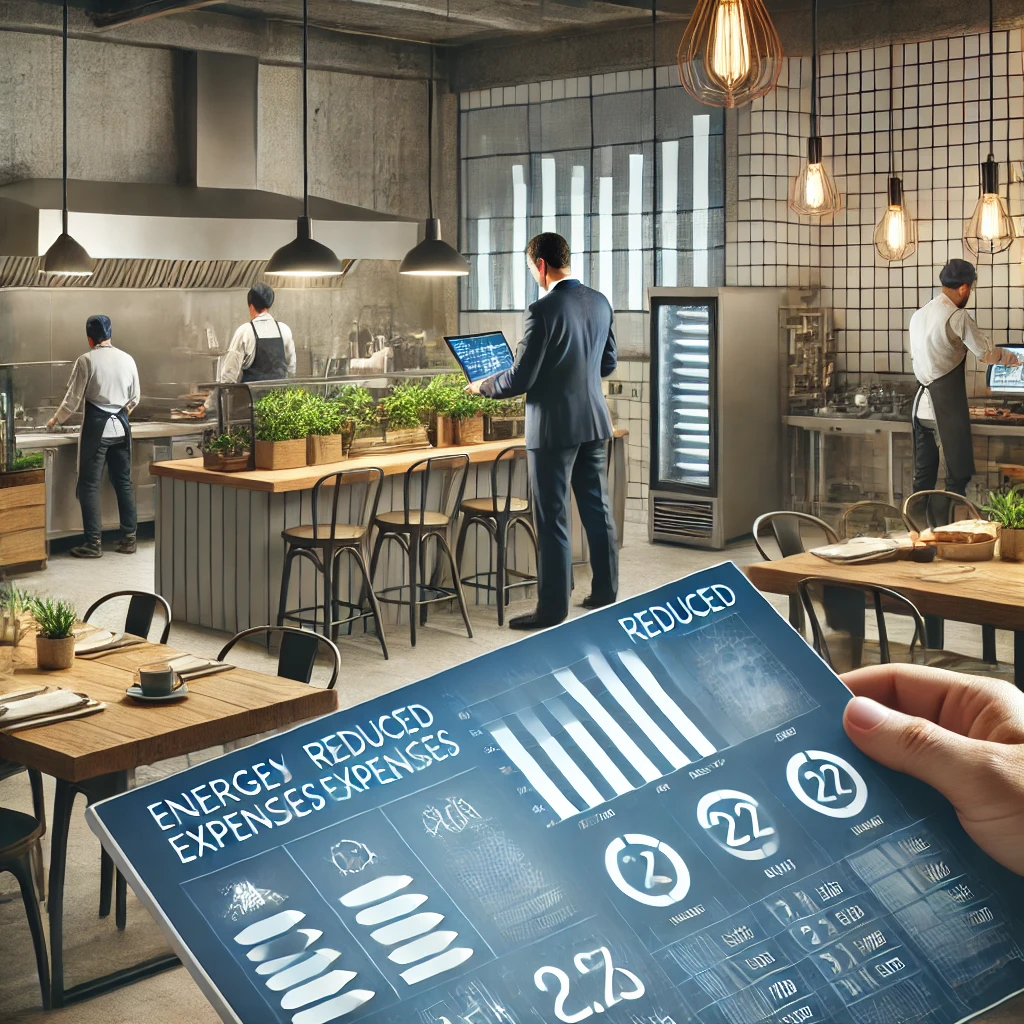Introduction
The modern commercial kitchen is evolving at an unprecedented pace. Gone are the days when a chef’s toolkit consisted solely of knives, pots, and traditional cooking equipment. In 2025, artificial intelligence has emerged as perhaps the most valuable tool in a chef’s arsenal, transforming kitchen operations from inventory management to menu planning and beyond. For chefs and restaurant owners navigating the competitive hospitality landscape, embracing AI-powered kitchen management isn’t just about staying current—it’s about survival and thriving in an industry where efficiency directly impacts the bottom line.
The integration of AI into kitchen operations represents a paradigm shift in how culinary professionals approach their craft. This technology doesn’t aim to replace the irreplaceable human elements of cooking—creativity, intuition, and passion—but rather to enhance them by eliminating inefficiencies, reducing waste, and providing data-driven insights that were previously unimaginable. In an industry where margins are notoriously thin and competition is fierce, AI offers a competitive advantage that forward-thinking culinary professionals cannot afford to ignore.
This blog explores how chefs and restaurant owners can harness the power of AI to revolutionize their kitchen operations, examining everything from inventory management systems to predictive maintenance and automated menu planning. We’ll delve into real-world applications, analyze return on investment, and provide practical guidance for implementation, regardless of your establishment’s size or current technological capabilities.
The Evolution of Kitchen Technology
The journey from traditional kitchens to AI-enhanced operations didn’t happen overnight. The hospitality industry has witnessed a gradual technological evolution, beginning with basic point-of-sale systems in the 1980s, advancing to computerized inventory tracking in the early 2000s, and now embracing fully integrated AI systems that can predict, analyze, and optimize nearly every aspect of kitchen operations.
This evolution reflects broader technological trends but is uniquely tailored to address the specific challenges of commercial kitchens: perishable inventory, fluctuating demand, labor constraints, and the need for consistent quality under pressure. Today’s AI kitchen management systems represent the culmination of decades of technological advancement, combined with a deep understanding of culinary operations and challenges.
From Analog to Digital: The First Wave
The initial technological transformation in kitchens focused on digitizing previously manual processes. Paper order tickets gave way to printed chits from computerized POS systems. Handwritten inventory sheets evolved into spreadsheets and basic database systems. These changes brought incremental improvements in accuracy and efficiency but still required significant human oversight and input.
During this phase, technology primarily served as a digital replacement for analog tools rather than fundamentally changing operational approaches. The benefits were real but limited—reducing calculation errors, improving record-keeping, and providing basic data for analysis.
Connected Systems: The Second Wave
The next significant evolution came with the integration of previously separate systems. POS systems began connecting directly to inventory management. Kitchen display systems replaced printed tickets. Cloud technology enabled real-time data sharing across multiple locations and devices.
This connectivity eliminated many manual data transfer points, reducing errors and providing more comprehensive operational visibility. Restaurant managers could now see how sales directly impacted inventory levels or how staffing patterns correlated with service times. However, these systems were still primarily reactive rather than predictive, reporting what had happened rather than what would happen next.
AI Integration: The Current Revolution
The latest and most transformative wave of kitchen technology centers on artificial intelligence and machine learning capabilities. Modern systems don’t just record and report data—they analyze patterns, identify anomalies, predict outcomes, and recommend actions. This represents a fundamental shift from technology as a tool to technology as a partner in kitchen management.
AI systems can now forecast demand with remarkable accuracy, optimize ordering to minimize waste, suggest menu modifications based on ingredient availability, and even monitor cooking processes to ensure consistency. The result is a kitchen that operates with greater efficiency, reduced waste, and improved quality control—all while freeing culinary professionals to focus on the creative aspects of their craft.
Core Applications of AI in Kitchen Management
Artificial intelligence is transforming nearly every aspect of kitchen operations, but several applications stand out for their immediate impact and return on investment:
Inventory Management and Ordering
Perhaps the most widely adopted AI application in kitchens, intelligent inventory systems are revolutionizing how establishments manage their ingredients and supplies:
Predictive Ordering:
AI systems analyze historical sales data, upcoming reservations, weather forecasts, local events, and even social media trends to predict demand with remarkable accuracy. These predictions drive automated ordering recommendations that ensure optimal inventory levels—enough to meet demand without excessive surplus that leads to waste.
Real-Time Inventory Tracking:
Modern systems use a combination of technologies—from smart scales and RFID tags to computer vision—to maintain real-time awareness of inventory levels. Some advanced systems can even track individual ingredient usage during service, automatically updating inventory without manual counting.
Waste Reduction:
AI excels at identifying patterns in food waste and suggesting corrective actions. By analyzing which items consistently end up as trim waste, spoil before use, or return from dining rooms uneaten, these systems recommend portion adjustments, ordering modifications, or menu changes to minimize loss.
A restaurant implementing AI-powered inventory management typically sees food cost reductions of 2-5 percentage points—a significant impact in an industry where net margins often hover around 5%. One mid-sized restaurant group reported annual savings of over $120,000 across five locations after implementing an AI inventory system, with ROI achieved in less than six months.
Menu Engineering and Development
AI is transforming how chefs approach menu creation and optimization:
Profitability Analysis:
Advanced systems analyze the true cost of each menu item—including ingredients, preparation time, cooking resources, and even plate real estate—and compare it against sales data to identify the most and least profitable offerings. This analysis goes far beyond traditional food cost percentages to consider the complete resource picture.
Trend Prediction:
By analyzing vast amounts of data from social media, food publications, search trends, and even local competitors’ menus, AI can identify emerging food trends and predict their relevance to a specific restaurant’s customer base. This helps chefs stay ahead of trends rather than chasing them.
Recipe Optimization:
Some systems can analyze recipes to suggest modifications that improve margin while maintaining quality—perhaps substituting a less expensive cut that works equally well in a braised dish or identifying seasonal alternatives to expensive out-of-season produce.
A casual dining chain that implemented AI-driven menu engineering reported a 14% increase in per-guest average spend and a 3.2 percentage point improvement in overall food cost, achieved by strategically highlighting high-margin items and adjusting recipes based on AI recommendations.
Kitchen Operations and Workflow
AI is streamlining how kitchens function during service:
Dynamic Ticket Sequencing:
Advanced kitchen display systems now use AI to optimize the sequence of ticket preparation based on complexity, cooking times, and station workload rather than simply displaying orders chronologically. This intelligent sequencing reduces bottlenecks and ensures more consistent timing.
Workstation Load Balancing:
AI systems monitor the workload across different kitchen stations in real-time and can suggest adjustments to balance production—perhaps temporarily reassigning certain tasks to underutilized stations during peak periods.
Quality Control Assistance:
Computer vision systems can monitor plated dishes for consistency with standard presentation, flagging potential issues before food leaves the kitchen. Some systems even monitor cooking processes, alerting chefs when items need attention based on visual cues rather than timers.
A fine dining restaurant implementing AI-driven kitchen operations reported a 23% improvement in ticket times and a 17% reduction in food returns due to quality or temperature issues, directly impacting both customer satisfaction and profitability.
Equipment Maintenance and Energy Management
AI is transforming the behind-the-scenes aspects of kitchen management:
Predictive Maintenance:
Smart systems monitor equipment performance metrics—temperature fluctuations, power consumption patterns, unusual sounds or vibrations—to predict potential failures before they occur. This allows for scheduled maintenance during off-hours rather than emergency repairs during service.
Energy Optimization:
AI systems analyze equipment usage patterns and can automatically adjust settings to minimize energy consumption without impacting performance. For example, intelligently staging the powering up of heavy-draw equipment to avoid demand charges or automatically adjusting refrigeration systems based on inventory levels and ambient conditions.
Resource Utilization:
Advanced systems track resource usage—water, electricity, gas—at a granular level and identify optimization opportunities that human observation might miss, such as equipment left running unnecessarily or inefficient cooking techniques.
A hotel implementing AI-driven equipment management across its food service operations reported a 22% reduction in maintenance costs and a 17% decrease in energy consumption, with the system paying for itself within the first year through avoided emergency repairs alone.
Implementation Strategies for Different Operations
The path to AI-powered kitchen management varies significantly based on operation size, current technology infrastructure, and specific needs:
For Small Independent Restaurants
Small operations face unique challenges but can still benefit from AI technologies:
Cloud-Based Solutions:
For small restaurants, cloud-based subscription services offer the most accessible entry point to AI kitchen management. These systems typically require minimal upfront investment and scale their costs based on usage, making them financially viable even for operations with tight capital budgets.
Focused Implementation:
Rather than attempting comprehensive technology transformation, small restaurants often see the best results by identifying their single most significant pain point—perhaps inventory management or labor scheduling—and implementing an AI solution specifically for that function.
Mobile-First Tools:
Many newer AI platforms are designed to work primarily through smartphones and tablets, eliminating the need for expensive dedicated hardware. These tools allow small operations to implement sophisticated systems using devices they already own.
A neighborhood bistro with 45 seats implemented a cloud-based AI inventory and ordering system using only the owner’s existing tablet. The system reduced food waste by 31% and decreased the time spent on inventory management from 12 hours weekly to just 3 hours, allowing the chef-owner to redirect that time to menu development and guest interaction.
For Multi-Unit Operations
Restaurant groups and chains have different considerations:
Centralized Data Architecture:
For multi-unit operations, creating a unified data ecosystem is often the critical first step. This infrastructure allows AI systems to analyze patterns across locations, identifying best practices that can be implemented system-wide.
Phased Rollout Strategy:
Successful chains typically implement AI systems in pilot locations before full deployment, allowing for process refinement and ROI validation. This approach also helps identify location-specific factors that might require customization of the AI parameters.
Integration Focus:
Multi-unit operations often have existing technology investments that cannot be immediately replaced. The most successful implementations focus on AI platforms specifically designed to integrate with legacy systems rather than requiring complete replacement.
A regional restaurant chain with 28 locations implemented an AI kitchen management system using a phased approach, beginning with three pilot locations. After refining the implementation process and documenting a 217% ROI in the pilot sites, they rolled out the system across all locations over six months, achieving consistent results throughout the organization.
For Hotel and Resort Food Service
Large hospitality operations present unique implementation challenges:
Cross-Department Integration:
In hotels and resorts, kitchen AI systems must integrate not only with restaurant POS systems but also with property management systems, banquet management platforms, and other hospitality software. This broader integration allows for more comprehensive demand forecasting and resource planning.
Multiple Venue Coordination:
Large properties often operate several food service outlets with shared resources. AI systems can optimize inventory and production across these venues, identifying opportunities for cross-utilization and reduced waste that would be difficult to spot manually.
High-Volume Analytics:
Resort properties with significant banquet and catering operations benefit particularly from AI’s ability to analyze large-scale production requirements and optimize staffing, preparation scheduling, and equipment utilization for maximum efficiency.
A luxury resort with six food service outlets implemented an integrated AI kitchen management platform that coordinated operations across all venues. The system reduced overall food cost by 3.2 percentage points while improving guest satisfaction scores, primarily through better cross-utilization of ingredients, optimized prep scheduling, and more consistent execution during peak periods.
Overcoming Implementation Challenges
Successfully integrating AI into kitchen operations requires addressing several common challenges:
Staff Adoption and Training
Technology is only effective when properly used:
Phased Training Approach:
Successful implementations typically begin with core functionality and gradually introduce more advanced features as staff comfort increases. This prevents overwhelming team members with too much change at once.
Identifying Technology Champions:
Designating specific team members—often younger staff who are naturally tech-savvy—as system experts creates internal resources for ongoing training and troubleshooting. These champions become advocates who help drive adoption throughout the team.
Emphasizing Benefits, Not Just Procedures:
Training that focuses on how the technology makes jobs easier rather than simply how to use it typically leads to better adoption. When staff understand the “why” behind new systems, they’re more likely to embrace them.
A restaurant that initially struggled with staff resistance to a new AI inventory system completely reversed this resistance by redesigning training to emphasize how the system reduced the most tedious aspects of inventory counting and freed up time for more creative work. Within three weeks, the same staff who had resisted the technology were suggesting additional ways to use it.
Data Quality and Integration
AI systems are only as good as their data:
Data Cleansing:
Many operations discover data quality issues when implementing AI systems—inconsistent naming conventions, inaccurate recipes, or incomplete historical records. Addressing these issues before full implementation is critical for system accuracy.
Integration Architecture:
Kitchens often have multiple existing systems that weren’t designed to work together. Creating a coherent integration architecture—whether through middleware, APIs, or comprehensive platform replacement—ensures consistent data flow between systems.
Ongoing Data Governance:
Establishing clear protocols for data entry, maintenance, and quality control ensures that AI systems continue to receive accurate information. This governance is particularly important for recipe management, where small inconsistencies can significantly impact inventory and costing calculations.
A restaurant group discovered during AI implementation that their recipe database contained significant inconsistencies—the same ingredients had different names across recipes, portion sizes were inconsistently recorded, and many recipes were outdated. They paused implementation to conduct a comprehensive recipe standardization project, which not only enabled successful AI deployment but also improved consistency across their operations.
Balancing Automation and Culinary Creativity
Maintaining the human element of cooking is essential:
Defining Appropriate Boundaries:
Successful implementations clearly define which aspects of kitchen operations should be AI-driven and which should remain under human control. Typically, routine operational decisions are automated while creative and guest-facing decisions remain with the culinary team.
Creating Feedback Loops:
Systems that incorporate chef feedback mechanisms allow the AI to learn from human expertise rather than simply imposing algorithmic decisions. This collaborative approach typically leads to better outcomes and higher staff acceptance.
Preserving Creative Space:
The most successful AI implementations actually increase creative freedom by handling routine tasks and providing inspiration rather than dictating outcomes. Chefs report having more time for innovation when freed from administrative burdens.
A restaurant known for its creative cuisine implemented AI inventory and ordering but specifically designed the system to support rather than constrain the chef’s creative process. The system identifies which ingredients need to be used promptly and suggests potential applications but leaves final menu decisions to the culinary team. This approach reduced waste by 34% while actually increasing the number of special menu items the team developed.
Measuring ROI and Performance Improvements
Quantifying the impact of AI kitchen management requires comprehensive measurement:
Financial Metrics
Direct financial impacts provide clear ROI validation:
Food Cost Reduction:
AI-powered inventory management typically reduces food costs by 2-5 percentage points through waste reduction, optimized ordering, and improved yield management. For a restaurant with $1 million in annual food sales, this represents $20,000-$50,000 in direct bottom-line improvement.
Labor Efficiency:
Automated systems reduce time spent on administrative tasks like inventory counting, order placing, and production planning. Operations typically report 15-25 hours of weekly labor savings for management staff, allowing redeployment to guest-facing activities or strategic initiatives.
Revenue Enhancement:
AI-driven menu engineering and recommendation systems typically increase per-guest average spend by 5-10% by highlighting high-margin items and creating more effective menu designs. This revenue improvement often exceeds the direct cost savings from operational efficiencies.
A casual dining restaurant with annual revenue of $2.8 million implemented a comprehensive AI kitchen management system at a cost of $24,000 for the first year (including implementation). The documented first-year financial impact included $42,000 in food cost savings, $35,000 in labor efficiency improvements, and $78,000 in increased revenue through menu optimization—a combined ROI of 646%.
Operational Improvements
Beyond direct financial metrics, operational enhancements create significant value:
Consistency Metrics:
AI systems typically improve consistency in portion control, preparation methods, and presentation. Operations using computer vision for quality control report 30-40% reductions in quality-related returns and remakes.
Speed of Service:
Intelligent kitchen display systems and workflow optimization typically reduce ticket times by 15-25% during peak periods while improving the consistency of timing between courses.
Inventory Accuracy:
AI-powered inventory management improves theoretical to actual inventory variance by 60-80% on average, providing much greater visibility into actual usage patterns and potential loss areas.
A fine dining restaurant implemented AI-driven kitchen operations and measured a 23% improvement in ticket times, 94% reduction in missed modifications, and 17% increase in kitchen staff satisfaction scores. These operational improvements contributed to a 31% increase in positive online reviews specifically mentioning food quality and service timing.
Long-Term Strategic Benefits
Some of the most significant benefits emerge over longer timeframes:
Data-Driven Decision Making:
As AI systems accumulate operational data, they enable increasingly sophisticated analysis and forecasting. Operations report that the quality of insights continues to improve over time, creating compounding returns on the initial investment.
Scalability Improvements:
Restaurants with AI kitchen management report 30-40% faster opening times for new locations due to more efficient training, standardized procedures, and transferable data models.
Adaptability to Market Changes:
Operations with AI-driven insights can respond more quickly to supply chain disruptions, cost increases, or consumer preference shifts. This adaptability has proven particularly valuable during periods of high inflation or supply uncertainty.
A restaurant group that implemented AI kitchen management across its concepts found that their most significant long-term benefit was improved concept development. By analyzing performance data across multiple locations and concepts, they identified specific menu items, preparation techniques, and service models that consistently outperformed others. This insight allowed them to develop new concepts with much higher first-year success rates and faster paths to profitability.
Future Trends in AI Kitchen Management
The evolution of kitchen AI continues at a rapid pace, with several emerging trends poised to further transform operations:
Advanced Sensing and Monitoring
Next-generation systems will have unprecedented awareness of kitchen conditions:
Computer Vision Expansion:
Visual recognition systems are becoming more sophisticated, enabling real-time monitoring of cooking processes, automated quality control, and even analysis of plate returns to identify patterns in customer preferences.
IoT Integration:
As more kitchen equipment incorporates smart sensors, AI systems will have access to increasingly granular data about cooking conditions, equipment performance, and resource utilization.
Environmental Monitoring:
Advanced systems are beginning to track environmental factors like air quality, temperature variations, and even noise levels to optimize both working conditions and food quality.
A technology research firm predicts that by 2027, over 60% of commercial kitchen equipment will include embedded sensors and connectivity, creating unprecedented visibility into kitchen operations and enabling much more sophisticated AI optimization.
Autonomous Kitchen Systems
Automation is expanding beyond management to actual production:
Robotic Integration:
While fully automated kitchens remain rare, specific stations—particularly high-volume, repetitive tasks like frying, grilling, and assembly—are increasingly augmented with robotic systems guided by AI.
Self-Adjusting Cooking Systems:
Next-generation cooking equipment can automatically adjust parameters based on ingredient characteristics, environmental conditions, and desired outcomes rather than simply following programmed recipes.
Autonomous Ordering and Inventory:
Advanced systems are moving beyond recommendations to fully autonomous ordering within defined parameters, requiring human intervention only for exceptions or unusual circumstances.
A food service automation specialist predicts: “Within five years, we expect to see ‘hybrid autonomy’ become the standard in high-volume operations, where routine production follows AI-optimized processes with minimal human intervention, while culinary staff focus on creative development, quality control, and guest interaction.”
Personalization and Customer Integration
AI is increasingly connecting kitchen operations directly to customer preferences:
Preference-Driven Production:
Advanced systems are beginning to track individual customer preferences across visits and automatically adjust preparation methods to match—slightly more done for one guest, extra spice for another—without requiring servers to enter special instructions.
Dietary Management:
AI systems are becoming sophisticated enough to automatically modify recipes based on specific dietary requirements, ensuring consistent accommodation of allergies, restrictions, and preferences.
Predictive Guest Experience:
By analyzing patterns in ordering, timing, and feedback, AI systems can begin to predict and prepare for specific guest needs before they’re expressed—perhaps having a favorite cocktail ready when regular guests are seated or preparing their usual modification without asking.
A hospitality technology expert notes: “The next frontier in kitchen AI is closing the loop between customer experience and kitchen operations. Systems that can connect individual guest preferences directly to production processes will create unprecedented levels of personalization at scale, fundamentally changing expectations for even casual dining experiences.”
Getting Started: Practical Next Steps
For culinary professionals considering AI implementation, several practical steps can help ensure success:
Assessment and Planning
Begin with a thorough evaluation of current operations:
Pain Point Identification:
Document specific operational challenges that technology might address—excessive food waste, inconsistent execution, labor-intensive administrative tasks, or difficulty maintaining consistency across locations.
Data Readiness Evaluation:
Assess the quality and accessibility of your existing operational data, including recipes, inventory records, sales history, and production procedures. Identifying data gaps early allows for remediation before implementation.
Technology Infrastructure Review:
Evaluate your current technology systems—POS, inventory management, scheduling tools—to determine integration capabilities and potential upgrade requirements.
A restaurant consultant advises: “The most successful implementations begin with a clear understanding of what specific problems you’re trying to solve rather than pursuing technology for its own sake. Identify your three most significant operational pain points and focus your initial efforts there.”
Vendor Selection and Implementation
Choosing the right technology partner is critical:
Industry-Specific Solutions:
Prioritize vendors with specific experience in food service operations rather than general business AI platforms. The unique challenges of kitchen environments require specialized understanding.
Scalable Entry Points:
Look for systems that allow phased implementation, beginning with core functionality and adding capabilities as your team becomes more comfortable with the technology.
Integration Capabilities:
Evaluate how potential solutions will connect with your existing systems, prioritizing platforms designed for interoperability rather than closed ecosystems.
A technology implementation specialist notes: “Request specific references from operations similar to yours in size, concept, and current technology infrastructure. The vendor’s experience with businesses like yours is often more important than their overall client list or feature set.”
Change Management and Training
Preparing your team for new technology is essential:
Early Stakeholder Involvement:
Include key staff members—particularly those whose daily work will be most affected—in the selection and planning process to build buy-in and gather valuable operational insights.
Phased Training Approach:
Develop a training plan that introduces functionality gradually, allowing staff to become comfortable with core features before adding complexity.
Success Metrics Definition:
Clearly define how you’ll measure the impact of the new technology, establishing baselines before implementation and tracking improvements consistently afterward.
A restaurant owner who successfully implemented AI kitchen management shares: “The single most important factor in our successful implementation was taking time to help our team understand how the technology would make their jobs better rather than just different. When staff saw the system as a tool to eliminate their most frustrating tasks rather than as surveillance or replacement, their attitude completely changed from resistance to enthusiasm.”
Conclusion: The Augmented Kitchen
As we’ve explored throughout this blog, AI-powered kitchen management represents not just an incremental improvement but a fundamental transformation in how culinary operations function. The most successful implementations approach this technology not as a replacement for human expertise but as an augmentation—handling routine tasks, providing data-driven insights, and creating space for the creativity and passion that remain uniquely human.
For chefs and restaurant operators navigating today’s challenging business environment, AI offers a powerful set of tools to address persistent industry challenges: thin margins, labor constraints, consistency demands, and intense competition. The technology has matured beyond experimental status to deliver proven, substantial returns on investment across operations of all sizes and concepts.
The future kitchen will increasingly be a collaborative environment where human creativity and technological efficiency work in concert. Chefs who embrace this partnership—understanding both the capabilities and limitations of AI—will find themselves with more time for innovation, more consistent operations, and more sustainable business models.
As you consider your own operation’s technology journey, remember that successful implementation is not about pursuing the most advanced features or the newest innovations. It’s about identifying your specific operational challenges and finding the right technological tools to address them. With thoughtful planning, appropriate partner selection, and careful change management, AI kitchen management can transform not just your operations but your entire approach to the culinary profession.












